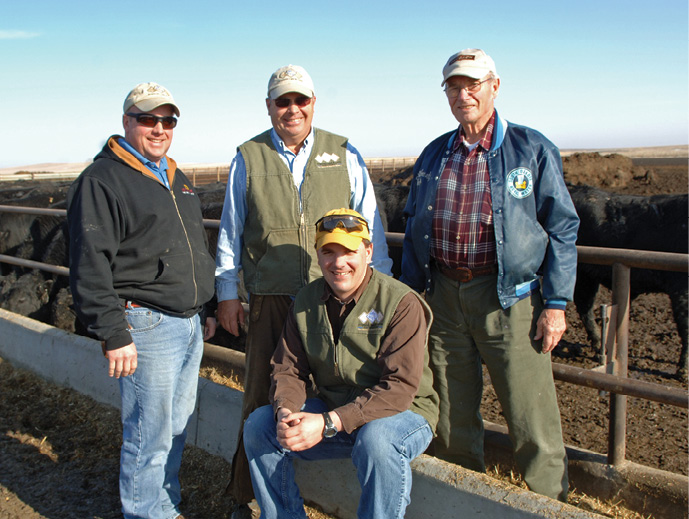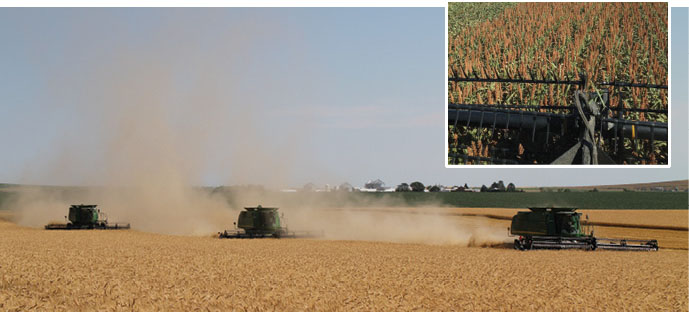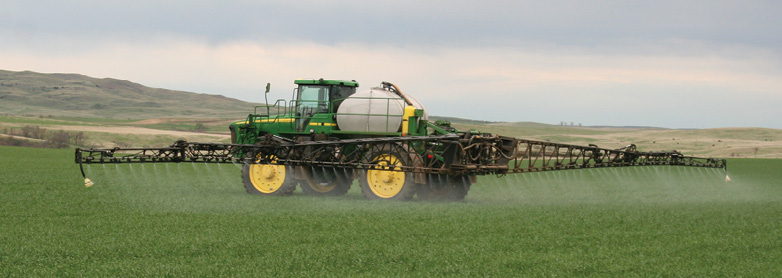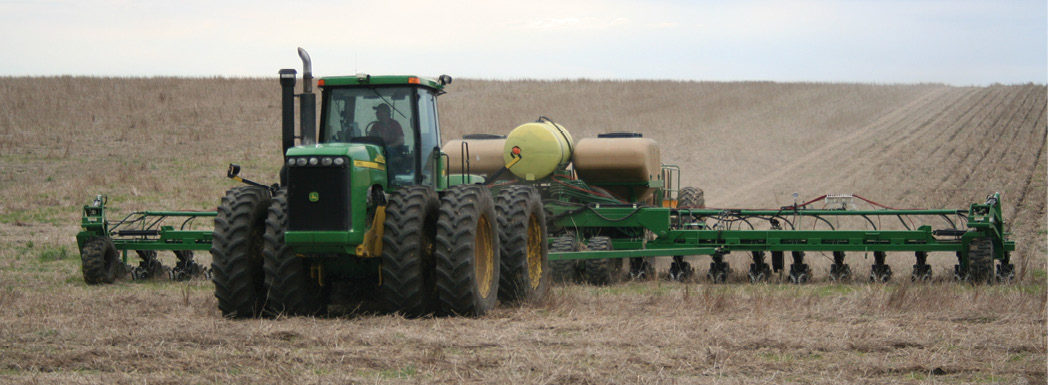Check The Specs...
NAME: Bryan Jorgensen
FARM: Jorgensen Land and Cattle
LOCATION: Ideal, S.D.
YEARS NO-TILLING: 30
ACRES: 11,000
CROPS: Winter wheat, spring wheat, oats, corn, milo, forage sorghum, soybeans, peas, alfalfa, millet, camelina, grass and teff grass
With the number of acres our family crops, you would think we would have a whole battery of equipment.
In reality, we crop and manage 11,000 acres of gently rolling South Dakota fields with a 48-row, 40-foot air drill; a 24-row, 60-foot planter; a high-clearance self-propelled sprayer with a 120-foot boom; two John Deere 9770 combines; and some haying and feeding equipment.
Every acre is planted every year. That’s a feat we could never have accomplished farming the way we did prior to the mid-1980s.
Back then, the standard for our part of the world was to raise a lot of winter wheat and summer fallow. That meant getting only one crop every two years.
Today, summer fallow is almost nonexistent here in south-central South Dakota due to no-till, crop diversity, better equipment and improved seed genetics. Instead of fallow, we see everyone getting nearly 100% utilization on their crop ground.
My family’s farm, Jorgensen Land and Cattle, is in its fourth generation of ownership. I’m the third generation and am in a partnership with my nephew, Cody Jorgensen. My brother Greg and son Nicholas are also minor partners.

We really got our feet wet in no-till back in the early 1980s when I was in college and my father was still active on the farm. At that time, interest rates were very high and land values and commodity prices were very low.
We were also struggling with drought conditions. There was a lot of economic and environmental pressure that was put on us farmers to get more production and sustainability from all of our acres.
By switching to no-till we immediately saved an immense amount of time, labor and fuel. At that point, we weren’t full no-till.
We didn’t have the equipment to no-till small grains, but our existing planters — with John Deere MaxEmerge row units — were up to the task of direct seeding corn and milo into wheat stubble.
Capturing and saving the little moisture we get in winter and spring was also a driving force in us going no-till.
We knew wheat stubble was where the most moisture was captured throughout the course of the year, so it was a logical place to start no-tilling into.
It wasn’t until the early 1990s that we purchased a Concord double-disc no-till air seeder and were able to go 100% no-till.
Mirroring Mother Nature
Dwayne Beck was an influence on our no-till system very early on. He was just getting going with the Dakota Lakes Research Farm in Pierre, S.D., and we worked closely with him to adopt no-till, and then develop our rotations to become even more productive and sustainable.
His main influence has been getting us into increasingly diverse rotations and catering our herbicide programs to fit those rotations.
When we first started no-tilling we were only raising winter wheat, milo and sorghum. We soon started adding crops and playing with our crop sequences to help with weed control, since glyphosate-tolerant crops weren’t an option at that point.
We wanted to use atrazine and metolachlor in corn and milo, but without some planning that wouldn’t allow us to plant cereal crops the next year, due to herbicide sensitivities.
Our solution was to use enough atrazine and metolachlor to milk the residual chemistry for 2 years of weed control. We would plant 2 years of a row crop — such as corn on corn, or corn on milo — and then plant oats or spring wheat once the atrazine and metolachlor were out of the system.
Today we have a lot more chemicals at our disposal and plant a wide array of crops. We are still able to front load residual chemistries because we plant crops in 2-year sequences.
Once we purchased our John Deere 1895 40-foot, 48-row no-till air drill, we started no-tilling more small grains, such as oats and alfalfa, and we’ve evolved into a 5- to 6-year rotation.
We plant 2 years of cereal grain, 2 years of row crops and then peas, soybeans or alfalfa. We want to stretch the rotation out even further so there are 6 or more years before we rotate back to a given crop. But right now, we generally are 2 years in, 2 years out.
This rotation helps us mimic, more or less, what Mother Nature does in our area as she cycles through different dominant plant species. We have cool-season crops, then warm-season crops, grasses and then broadleaves. This longer cycle also serves to break insect and weed cycles and gives us a lot more planting and harvesting windows.
If we were just growing corn and soybeans we would have only two planting windows and two harvest windows. Our entire lifestyle and profitability would hinge on those two opportunities, and you would have to have equipment that is sized and capable of covering a tremendous number of acres very quickly.
With a diverse cropping rotation I have more than 10 opportunities for planting and 10 opportunities to harvest, and I distribute my workload over 6 or more months instead of 3 weeks at both planting and harvest.
This also spreads out the use of my equipment and labor, lessens risk and changes everything for the better. I’m able to seed 11,000 acres with one 24-row corn planter and one 40-foot air seeder.
Fertility Shift

Our fertility strategy has changed a lot in the 30 years we’ve been no-tilling.
For many years after we made the switch we kept along with our old fertility paradigm. We would spread nutrients on the surface and allow them to naturally work their way into the system.
But as we kept no-tilling we noticed our soils were improving in tilth and organic matter. When we first started no-tilling, our soil organic matter was 1.5% to 2%, now it’s sitting at 4.3%.
Since our soils were working better, we made the switch from spreading dry urea and phosphorus on the surface to using in-furrow liquid phosphorus and banding nitrogen beside the row. The precise placement and active soils allowed us to gradually cut our nutrient inputs — mostly nitrogen — by 30% to 50%.
In the early 1990s, we finally decided to take a better look at our soils and determine what they really needed for fertility.
When soil testing, we don’t look at the fertilizer recommendations. We find a lab that will tell us what the soil chemistry and makeup is and give us the information to determine how efficient our soils are.
When I get a soil test I look at soil organic matter, available phosphorus (P1), unavailable phosphorus (P2), cation exchange capacity (CEC) — to see the soil’s ability to hold and store nutrients — and base saturations, which is the chemical makeup of the soil itself.
After initial testing in the early 1990s, we saw that our organic matter was still low, both forms of phosphorus were very high — due to years of blanket applications — and our CEC was also low.
Our base saturations, however, were all in good ranges, with the correct balance of potassium, magnesium, calcium, hydrogen and sodium. With that information, we knew we had a good slate to work from and that we just needed to start cranking up our soil’s biological system.
No matter how you apply nutrients, it’s soil biology that allows the soil and plant to build a relationship that allows for the use of nutrients. We started giving our soils a boost at planting by using products in our starter fertilizer that contains enzyme catalysts and amino acids to help the soil-biological system grow and prosper.
Thanks to our no-till system building organic matter, and our efforts to get the soil organisms working, we’re applying no more than 13 pounds total of phosphate in the furrow.
All nitrogen and sulfur is applied beside the row at about half the level universities recommend for our crops. We use 65 units of nitrogen and 15 units of sulfur on corn, and 75 units of nitrogen and 15 units of sulfur on wheat.
Even though we’re not putting any extra nutrients on, we’re still achieving high yields, the soil is healthier, our crops are healthier and we make better feed and seed.
Quality, Not Quantity

We don’t apply a lot of nutrients, but want to make what we do apply count. Most of our nutrients are applied with our planter and air drill.
Everything we plant gets 7-25-5 Summit Gold in-furrow as a starter. It’s different from the conventional 10-34-0 starter because it’s composed of 85% ortho phosphates, which are immediately available to the plants.
Conventional starter is comprised of 50% poly phosphates, which are not immediately plant available. The 7-25-5 also has a very low salt index so we can put it directly on the seed.
We apply this starter to all of our crops, including winter wheat, corn, milo and soybeans. It’s important to have that plant-available phosphorus right there when the seed germinates because it’s an energy source.
The energy in the seed is expended rapidly, so if we give the new root a convenient and available energy source it will form a larger root system and emerge faster. We want to get that plant to the surface and collecting sunlight for energy as soon as possible.
Virtually everything we plant also gets Summit Gold’s biological products, ProZyme and MaxGrow, in furrow. These are two different types of food for two different soil organisms: One is an energy source for bacteria, and the other for fungi.
These products aren’t a silver bullet, but helped us build a stronger base of bioactivity in the soil by providing food and enzymes for soil microorganisms.
That stronger soil life relates to more efficient use of applied nutrients and allows us to mine more nutrients from the soil. It also works with no-till and cover crops to help build soil structure.
We want the soil to be tilthy. The soil has to be able to breathe to oxygenate itself and manage water. We don’t want the soil to be drenched or dried out. We want it moist, warm and full of oxygen so biology can establish around the root system more quickly and start getting nutrients to the plant.
When we get a new piece of land to farm, we see an immense difference in the texture and productivity of those soils as compared to our long-term no-tilled soils.
We even see a difference when we take in farm ground that was previously no-tilled. It usually takes us about 3 to 4 years to get a new field up to our standards, and I think the biological products help speed up that process.
If I didn’t think they weren’t doing something, I wouldn’t be using them. I spend about $15 to $20 per acre with the biologicals, but we don’t apply high rates of nitrogen, phosphorus and potassium anymore, so our overall inputs are lower.
The majority of our nutrients are applied 3 to 5 inches beside the row (5 inches with the air drill, 3 inches with the planter). We use liquid 28% or 32% with Thio-Sul with the planter, and with our three-rank air seeder we’re able to place dry urea and dry ammonium sulfate 5 inches beside the row.
Micro Rescue

There are some instances where we will make foliar applications of micronutrients.
When it gets really hot and dry, or cold and wet, not only are plants stressed, but soil biological activity shuts down, impeding the plant’s ability to capture nutrients from the soil. At that point, we step in and apply foliar fertility.
What product we use depends on the crop. Mostly we use our John Deere 4920 self-propelled, high-clearance sprayer with a 120-foot boom to apply nitrogen or phosphorus with micronutrients that get plants through stress periods. On spring grains, such as spring wheat, winter wheat and oats, we’ll band on 28% nitrogen to build protein levels.
Included in our foliar applications are SummitGold products MaxGrow (contains soil enzyme activators, plant growth hormones and specialized sugars to feed microorganisms) and Krystal Klear Agra Mix III (micro package: boron, copper, iron, manganese and zinc) which help the plant set up natural defense mechanisms and provide nutrients during the stress period.

In corn, small grains and soybeans we see the most benefit to foliar applications of micronutrients when they’re applied toward the end of the vegetative stage and beginning of the reproductive cycles.
In cereals we apply in the mid-vegetative to late-flowering stages. With soybeans we apply between late V6 and R2, when the plant starts to flower, and in corn we apply between V6 to V8, right before tassel.
Cereals tend to get a foliar application every year because they’re a cool-season crop and go into their reproductive stages when temperatures are still low and soil biological activity hasn’t revved up yet. We find it’s also critical on grains from a disease standpoint.
We do currently use a foliar fungicide on our cereal crops, but want to work away from that because fungicides kill the good soil fungi along with the bad. We’re trying an experimental product from SummitGold that may help us set up mechanisms in the soil that will stop bad pathogens without a fungicide.
Covers And Cattle
Cover crops are of enormous importance for me. I’ve been planting cover crops for 6 years now, seeding them predominantly behind winter wheat.
We seed them at a shallow depth with our air drill, usually having someone start seeding when we’re about two thirds of the way through wheat harvest. They come up and are used for late fall grazing from November through January. They also serve to capture and hold any extra nutrients and continue to ramp up soil health that we’ve built up over the years.
We also sell certified winter wheat, spring wheat and oat seed, run a guided hunting business and sell Angus seed stock, marketing about 3,000 bulls per year.
Before no-till, and now cover crops, I wouldn’t have considered putting cattle on a lot of our crop acres. The foot traffic would have caused terrible compaction in our tight clay soils. After years of no-till, however, our soils are strong and can easily support the load.
We don’t really worry about compaction except near watering areas and where we have heavy truck traffic.
I seed a complex cover-crop mix that totals 20 to 25 pounds of seed per acre. The mix includes a couple pounds each of turnips, radishes and rapeseed; several pounds of Austrian winter peas and 5 to 10 pounds of oats. Planting a diverse mix is great for our soils and our cattle.

I’m always trying to be multidimensional with our cropping system, and this includes cover crops.
The more diversity I have in the root community, the more opportunities I have to host and encourage different microorganisms. For example, I know that the beneficial mycorrhizal fungi don’t do well on brassica roots, but are very fond of the oat roots in our mix.
Just as there’s more diversity for life below the soil surface, there’s more diversity for the cattle I graze, too.
Every year we turn 1,000 bulls out on cover crops and they pretty much support themselves. Normally, when I’m grazing bulls, I have to supplement them with mineral and a little hay.
When I graze bulls on a cover mix they don’t even look at minerals or hay that I put out. Their needs for minerals and energy are being covered 100%. It’s effective and efficient. I can roll out a fresh alfalfa bale and they won’t even look at it. It’s unbelievable.
The cost to graze our bulls on cover crops in the field is about $1.30 per day, compared to $2.50 per day if they were being fed at the bunk.
Multiply that over 1,000 head and that’s savings of about $1,200 per day. And that doesn’t encompass the soil benefits we get from the cover crops, and the fact that the cattle are cycling nutrients right back into the soil.
My goal is to have hoof prints on every single acre. There will be some investment, as we’ll have to install fencing and set up watering facilities, but the benefits are worth it.
We already plant about 800 acres of cover crops per year, and this year we’ll be experimenting with new seeding methods to get on even more acres. We’re going to hire a high-clearance air flow machine to broadcast our cover-crop mix on corn at the V6 stage.
Controlling Variables
Everything we do wrong, from the moment we open the seed bag, diminishes yield.
We know placing seed accurately, and not compacting the seed zone, can gain us 6 to 15 bushels in corn. Because of that, we try to control as much as possible with our equipment.
We are currently setting up a John Deere DB series 24-row planter. It will have Martin row cleaners, Martin single-disc fertilizer openers (UMOs) offset 3 inches from the row, Keeton seed firmers and Martin spading closing wheels and drag chains.
We like the Martin products, especially the heavy-built row cleaners, because they seem to work well in most all situations. This is good because we plant into wheat and corn stubble and sod, and this setup is able to handle every change.
We set our residue managers so they only move about 60% to 70% of the residue. We control the depth and pressure on the row cleaner through the Precision Air Force system. We don’t want too much soil cleared in front of the openers or we get mud buildup due to our clay soils.

Exciting additions to our new planter are the Precision Planting DeltaForce hydraulic down-pressure system and Precision Planting vDrive electric seed meters. These products basically turn our 24-row planter into 24 separate planters on one toolbar.
Each row unit acts independently to automatically adjust down pressure and seed placement and population. It processes information 200 times per second so it can adapt almost instantly as we go from soft to hard soils to provide precise seed placement.
We had an airbag system on our previous planter but it couldn’t react as quickly. This technology, plus Field View — which takes information from our 20/20 SeedSense monitor and uploads it to a cloud server so we can view it on our iPad right in the field — helps us fix errors as they’re happening, not after they’ve already been made.
Through no-till, crop rotation and all of the other work we’ve done to capture moisture, build soil health and, in general, improve our cropping enterprises, we’ve been rewarded with drastically increased yields.
In the 1980s we considered 30- to 40-bushel wheat to be a win. Now it’s nothing to get 90- to 120-bushel wheat.
Our corn yields have risen from 40 to 50 bushels per acre to 150 bushels per acre, and soybeans from 10 to 50 bushels per acre. Our forage crops have jumped from 2 to 3 tons per acre to 6 to 8 tons per acre.
The increase in productivity is obvious. We’ve also seen a marked improvement in plant health and seed and forage quality. I believe these changes are due to our across-the-board systems approach.A
The No. 1 factor is building good soil health (especially not tilling, which destroys the soil), and the No. 2 factor is improvement in our seed placement and nutrient placement.
It all goes back to controlling what you can and moderating the rest.








Post a comment
Report Abusive Comment